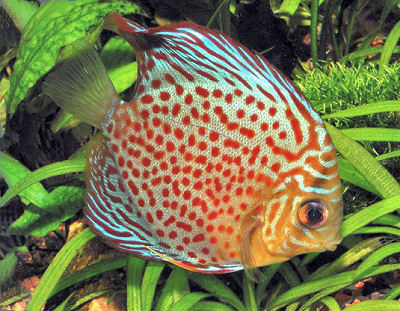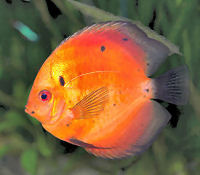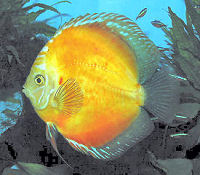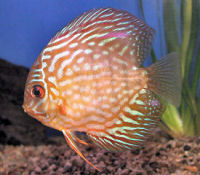The elegant and regal Discus have been entitled the “King of the Aquarium Fishes”!
The majestic, graceful, and dignified Discus fish has been described as the “King of the Aquarium Fishes” for good reason. They are highly esteemed within the fish keeping hobby due to their dramatic coloring, refined shape, and regal bearing and are widely considered to be the pinnacle of tropical fish keeping. These quiet, peaceful, and elegant creatures inspire appreciation and dedication like no other fish.
Discus are considered part of the cichlid family and are categorized into three species, two of which have been long time standards and one which has been relatively recently described. The Green Discus Symphysodon aequifasciatus and its close relative the Heckel Discus or Red Discus Symphysodon discus are the most recognized species. These two are found in the central and lower Amazon regions and are very similar in coloring and behavioral disposition. Both are considered valid species by the scientific community. The third species, the Blue Discus or Brown Discus Symphysodon haraldi, was recently identified by Mr. Heiko Bleher and is awaiting further work to determine identification and validation.
There are many local color varieties, possibly due to natural hybridization, though most available Discus today are tank bred varieties. Through selective breeding a wide variety of body shapes, colors, and patterns are being produced. These tank bred varieties are widely divergent from the wild caught discus and tend to be better adapted to tank life, requiring less stringent care than their wild caught brethren. Even so, tank bred Discus are more demanding of good water quality, require a larger aquarium, and are more expensive than many tropical fish.
Discus were first imported into the United States and Europe in the 1930’s and 1940’s. Early efforts to ship and keep these fish proved exceptionally difficult, but much more is now known about their needs and requirements. An experienced and dedicated aquarist will find these fish a challenging and rewarding experience.
For Information on keeping freshwater fish, see:
Freshwater Aquarium Guide: Aquarium Setup and Care
Wow. A huge spectrum of 28 different Discus varieties all captured in the same shot and in the same tank. It’s difficult to tell which fish is from which particular variety since there are simply so many, but if you are looking for a specific variety it is likely this video has a shot of it! Great video!
- Kingdom: Animalia
- Phylum: Chordata
- Class: Actinopterygii
- Order: Perciformes
- Family: Cichlidae
- Genus: Symphysodon
- Species: aequifasciata
- Aquarist Experience Level: Advanced
- Size of fish – inches: 10.0 inches (25.40 cm)
- Minimum Tank Size: 50 gal (189 L)
- Temperament: Peaceful
- Aquarium Hardiness: Difficult
- Temperature: 82.0 to 88.0° F (27.8 to 31.1° C)
- My Aquarium – Enter your aquarium to see if this fish is compatible!
- Beginner Fish – Freshwater fish for beginners
- Community Fish – Peaceful Freshwater fish
- Hardy Fish – Hardy Freshwater fish
- Similar size fish – Fish that are 1 inch bigger or smaller
- Coldwater Fish – Looking for cold water fish? (65 °)
Habitat: Distribution / Background
Discus are native to the South American countries of Brazil, Peru, Venezuela, and Columbia and are found inhabitating the tributaries of the Amazon River within those countries. These fish had previously been divided into several suggested species along with a number of subspecies, however, more recently there have been revisions of the Discus genus. From the study results published in the Journal of Fish Biology by Bleher, et al in 2007; and by Ready, Kullander, and Ferreira in 2006, three species are currently acknowledged and the classification of subspecies was eliminated.
The three acknowledged species include the Green Discus Symphysodon aequifasciatus and the Heckel Discus or Red Discus Symphysodon discus. These are both considered valid species by the scientific community. The third species, identified by Heiko Bleher, is the Blue Discus or Brown Discus Symphysodon haraldi. It is awaiting further work to determine identification and validation.
- Green Discus Symphysodon aequifasciatus
The Green Discus was described by Pellegrin in 1904. They originate in the central Amazon region, mostly from the Putumayo River in northern Peru, and from Brazil near Santarem and the lake of Tefé. Other common names they are known by are Red Spotted Discus and Tefé Discus.
- Heckel Discus Symphysodon discus
The Heckel Discus or Red Discus was described in 1840 by Dr. Johann Jacob Heckel. They are native to South America, originating from Brazil in the Rio Negro, Rio Trombetas north of the Amazon, and from the Rio Abacaxis south of the Amazon. This species, also commonly known as the Red Discus, is a bit more unique. See the Heckel Discus or Red Discus page for more information on this species
- Blue DiscusSymphysodon haraldi
The Blue Discus was described by Schultz in 1960. This species can be found in the lower Amazon region. It is recognized but is awaiting further work to determine its validation. Other common names they are known by are Brown Discus.
A more recently discovered discus found in the western Amazon regions in 1959 is distinguished by a unique color form, sporting red spots on the anal fin and the body. Some have suggested that it be identified as Symphysodon tarzoo. However in a discussion with Mr. Bleher, he identifies it is the Green Discus. He says, “S. aequifasciatus – the Green Discus is found only in some areas of western Amazonia” and that… the name S. tarzoo is a synonym (a nomen nudum, or not an existing name)”.
Discus fish live in the still or slow moving waters along the banks where they hide among tangled roots and branches. They feed on insect larvae, insects, and planktonic invertebrates.
- Scientific Name: Symphysodon aequifasciata
- Social Grouping: Groups
- IUCN Red List: NE – Not Evaluated or not listed
Description
WFCiam_U112_med.jpg) Wild caught Discus Symphysodon aequifasciatus Photo Courtesy: Heiko Bleher Wild caught Discus Symphysodon aequifasciatus Photo Courtesy: Heiko Bleher |
Discus are relatively large disc shaped cichlids. Depending upon the variety, they can reach up to about 6 -10″ (15 – 25 cm) in length. They are the most laterally compressed (flattened) of all the cichlids. Within each species there is great variety in shading, patterning, and body types.
Through selective breeding there are a wide variety of body shapes, colors, and patterns being produced. Captive bred varieties can also be variants of the wild form or be hybrids. Either way they are widely divergent in appearance from wild caught discus. They are also much more adapted to aquarium life and are easier to maintain than their wild caught brethren, though they still require very dedicated care.
Green Discus: Symphysodon aequifasciatus
The Green Discus S. aequifasciatus,a.k.a. Red Spotted Discus or Tefé Discus, are moderate in size and reach a lenght of about 6″ (15 cm). Interestingly, though tank bred individuals can be highly variable in color and patterning, the wild caught individuals tend to be rather bland and unremarkable.
Instead of the dramatic coloring of the tank bred Discus, the wild Green Discus presents a dark brownish to green body. They have nine vertical bars along the body, but lack a bold centrally located bar. They have irregular metallic streaks along the belly, dorsal fin, anal fins, and on the dorsal area of the body of green, blue, or turquoise.
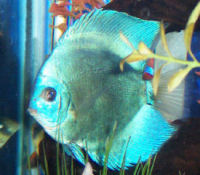 Turquoise Discus Courtesy Marisa Monaco | 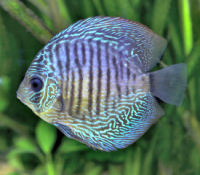 Blue Discus (hybrid) Courtesy Greg Rothschild |
| 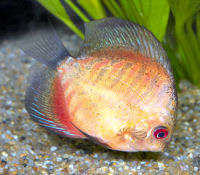 Red Turqoise Discus (hybrid) Courtesy Greg Rothschild |
The Green Discus are perhaps the most popular of the three discus species. They are also the Discus which has been the focus of most of the development work and thus more is known about them and their classification information than any of the other Discus.
Some color variants of the Green Discus include:
- Solid colored varieties
The desire to develop a solid blue color varietywas one of the first challenges facing earlyDiscus keepers and breeders. Once the variety was developed, the challenge was adapted to produce a solid red Discus. This hasn’t been achieved quite yet, but many dedicated breeders are continuing to work on it. - Turquoise varieties
Of the many strains of captive bred Discus, the turquoise varieties are the most available. They are generally found in greens or blues. They can be solid or have vertical bars, and some will have beautiful effervescent color streaking.
They have names such as Brilliant Turquoise Discus, Red Turquoise Discus, Giant Turquoise Discus, and Cobalt Turquoise Discus. - Red varieties
The Red Spotted Discus or Tefé Discus is one of the most striking variants. It has red spots on its belly and tail, and sometimes over the entire body. It is also quite rare and expensive. - “Royal” – Streaked varieties
These are popular strains that have blue or green streaks over the entire body. They are called the ‘Royal’ Green Discus or ‘Royal’ Blue Discus.
Blue Discus, Brown Discus: Symphysodon haraldi
The Blue DiscusS. haraldi,a.k.a the Brown Discus, is considered one of the most beautiful and hardiest discus. They reach a length of about 5 inches (13 cm) and have a much more varied color pattern and can have a larger number of vertical bars (8 to 16) than either of the other two species of discus. They are not as colorful as the Green Discus or the hybrids.
Other common names they are known by include Common Discus, Gypsy, Semi Royal Blue, and Royal Blue. Although these two are the same species, there are some characteristic differences between the two types.
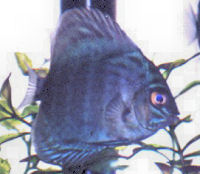 Dark Blue Discus Courtesy Jim Shiel |
|
|
|
- Blue Discus varieties
Blue Discus varieties are very similar to the Brown varieties, though the Blues tend to have a slightlylonger bodywhile the Brown’s is more rounded. They have a darker, almost purple brownbody and nine vertical bars without a bold central bar. They often have blue horizontal stripes on the head, dorsal and ventral fins. The face is a deeper brown.
Some hybrid strains are called Cobalt Discus, Powder Blue Discus, and Sky Blue Discus. A real beauty is the Cobalt Blue Discus. It is almost entirely blue andsometimes presents a dazzlingmetallic sheen. Other specialties will sometimes have blood red spots on the dorsal fins.
- Blue Discus varieties
- Brown Discus varieties
Brown Discus varieties originate in the lower Amazon region in Brazil. They have light to dark brown bodies (sometimes reddish) and nine vertical bars (without the bold central bar). There are irregular streaks on the upper and lower fin areas. They usually display a yellowish coloring at the base of the dorsal fin, around the eye, and on the snout.
They were regularly kept for a long time, however they are not as colorful as other varieties and are now less available.
Redder body colors are sometimes enhanced by adding such things as prawn eggs to their diet, or by adding chemicals to their water. This enhancement is not permanent and will fade in a couple of weeks. (The pictures shown here are captive bred hybrids).
- Size of fish – inches: 10.0 inches (25.40 cm) – Normally about 6 inches in the wild and have been documented up to 9 inches in aquariums.
- Lifespan: 10 years
Fish Keeping Difficulty
The Discus should be kept only by an experienced fish keeper. They are notoriously diffucult to keep and have a reputation of intimidating even very experienced aquarists. One of the more challenging aspects of keeping Discus fish is the process of acclimating them to their new tank. Medium sized or larger Red Discus tend to respond the best to being transferred, yet even they find the process traumatic and stressful. This sensitivity coupled with the fact that Discus tend to grow fairly large implies it would be wise and humane to take steps to ensure they will not be moved very often or caused unwarranted stress. In other words, if you are considering buying a Discus fish you should consider buying an aquarium that will be suitably large enough to accommodate them no matter their size or life cycle. Try to buy aqarium setups that can act as permanent, as opposed to temporary, habitats for your Discus.
When purchasing a Discus make sure to inspect the fish very well for signs of disease as they are very prone to ich and other stress related diseases that can be transfered into their new home and have a negative reaction on other tankmates.
- Aquarium Hardiness: Difficult
- Aquarist Experience Level: Advanced
Foods and Feeding
Since they are carnivorous Discus will generally enjoy a wide variety of all kinds of live and frozen foods. Foods such as both frozen and live brine shrimp, bloodworms, chopped beef heart, and whiteworms are readily eaten by Discus. In addition, tank bred Discus are sometimes known to accept food in a flake or pellet form, though in general most Discus prefer the “real” thing. Be sure your food choices are high in quality and nutrition and that you provide a broad spectrum of different foods. Also, though they are carnivorous, they may enjoy eating small quantities of vegetation based foods and these should be offered every so often if your particular fish enjoys them.
Keep in mind they are slow feeders and take care to ensure they eat plenty of food, especially if they are living with rambunctious and hungry tankmates.
Also note, any live or dead material which is introduced into the aquarium has the potential of introducing dangerous bacteria or parasites into the aquarium. Therefore, it is recommended to quarantine any live foods in a seperate tank prior to feeding them to your Discus.
- Diet Type: Carnivore
- Flake Food: Yes – High quality, vitamin enriched is strongly recommended.
- Tablet / Pellet: Yes
- Live foods (fishes, shrimps, worms): Half of Diet
- Vegetable Food: Some of Diet
- Meaty Food: Half of Diet
- Feeding Frequency: Several feedings per day
Aquarium Care
Discus require a strictly adhered to water change regiment of at least 25% every week. Discus are very sensitive to water fluctuations so make sure to test any water going back into the tank. Make sure when doing water changes to carefully vacuum the substrate throughly. Before vacuuming use a sponge or algae magnet to clean viewing panes and once the removed algae has settled on thebottom start vacuuming.Take great care when cleaning the tank to not cause unwarranted or excess stress to your fish as they are very prone to stress related diseases.
- Water Changes: Weekly – Very important with this fish. Make sure water that is added back to tank is similiar in temp, pH, and hardness.
Aquarium Setup
A minimum 50 gallon aquarium is suitable for a single fish, though a much larger tank would be needed if keeping more. Because these fish are as tall as they are long, taller ‘show’ type tanks work best. They need good water movement along with strong and efficient filtration. Discus prefer an aquarium with warm, soft, and slightly acidic water; they tend to prefer wamer water than most tropical fish. Lower termperatures have the effect of increasing the Discus’ susceptibilty to death and disease.
Discus have a timid nature and dislike moving shadows, excessive vibrations, and overly boisterous tank mates. It is best to keep their aquarium out of areas that have high traffic, lights being turned on and off, or rooms that are noisy. They are also very shy and more active at night.
A planted aquarium with an open area for swimming suits them well, but the plants need to be varieties that can tolerate warmer temperatures of 82° F and up. Some good plants selections are rosette plants like the Dwarf Lily Bulbs, Anubias Nana, MicroSword Grass, Jungle Vallisneria, Corkscrew Vallisneria, Water Onions, Ozelot Swords, Rangeri Swords, and Didplis Diandra; some of the aquatic stem plants like Rotala Indica; and some of the fern and moss type plants like the Java Fern and Subulata.
When you are first introducing these fish to your aquarium, refrain from bright lighting and be certain to provide caves and places for the fish to hide. They may initially prefer subdued lighting because of their shyness, but once they become comfortable normal aquarium lighting works fine.
Though difficult to care for and rather picky in their prefered aqaurium setup, Discus can provide great amounts of satisfaction to a diligent and observant fishkeeper.
- Minimum Tank Size: 50 gal (189 L) – 50 gallons for a single fish. This is a tall fish so tank height also needs to be kept in mind as well as length.
- Substrate Type: Sand/Gravel Mix
- Lighting Needs: Moderate – normal lighting – Be certain to provide many shaded and secluded spots for your fish to hide in and be sheltered from the light.
- Temperature: 82.0 to 88.0° F (27.8 to 31.1° C)
- Breeding Temperature: – 82 – 88° F (27.7 – 31° C)
- Range ph: 6.0-6.5
- Hardness Range: 10 – 15 dGH
- Water Movement: Moderate
- Water Region: All
Social Behaviors
Unlike many others in the cichlid family, discus are peaceful and highly social. They are not predatory and they do not burrow in the substrate. They are a schooling fish and prefer to be kept in groups of around 6 fish, but may not do very well if kept alone. Several discus can be kept together and they can be kept with some of the more peaceful tropical fish. They are slow feeders and need companions with a similar temperament.
Examples of good community companions would be a pair of dwarf cichlids or some clown loaches. Also a school consisting of 15 – 20 individuals of a single species of tetra works well. Good selections include Characin species like the Cardinal Tetra, Neon Tetra, Rummynose Tetra, Glowlight Tetra, Emperor Tetra, or Congo Tetra. It is suggested that you avoid Angelfishes and Corydoras Catfish, as these fish are prone to carrying internal parasites that can infect the discus.
- Temperament: Peaceful – Can get aggressive while spawning.
- Compatible with:
- Same species – conspecifics: Yes
- Peaceful fish (): Safe
- Semi-Aggressive (): Threat
- Aggressive (): Threat
- Large Semi-Aggressive (): Threat
- Large Aggressive, Predatory (): Threat
- Threat
- Shrimps, Crabs, Snails: May be aggressive
- Plants: Safe
Sex: Sexual differences
Although it is hard to distinguish the sex, during breeding season the male will have a more pointed papillae while the female’s is rounded. Males may be larger and some males have a more pointed dorsal fin and thicker lips.
Breeding / Reproduction
Discus form nuclear families but will readily cross-breed with other discus. They are egg layers and will attach their eggs to plants, driftwood, rocks, and ornamentation in the aquarium. Though spawning and rearing of fry can be successful in harder water, for fertilization and egg development they require a total hardness no higher than 6° dGH. Water conditions for breeding should be slightly acidic, soft and warm. Have a pH of about 5.5 – 6°, hardness at about 3-10° dGH and have temperatures between 82 – 88° F (27.7 – 31° C).
The female will lay between 200 – 400 eggs which will hatch in about 60 hours. Fry consume a special mucus on the skin of the parents for the first 5 or 6 days. See more about cichlid breeding in: Breeding Freshwater Fish: Cichlids.
- Ease of Breeding: Moderate
Fish Diseases
The Discus are susceptible to typical fish ailments, especially if their water is stale and of poor quality and oxygenation. They tend to be susceptible to illness when stressed, usually caused by not providing ample hiding places. One common problem is Ich. It can be treated with the elevation of the tank temperature to 86° F (30° C) for 3 days. If that does not cure the Ich, then the fish needs to be treated with copper (remove any water conditioners). Several copper based fish medications are available for Ich. Copper use must be kept within the proper levels, so be sure to follow the manufacturers suggestions. A copper test also can be used to keep the proper levels. You can also combine increasing the temperature with an Ich medication treatment. Intestinal disease can be treated with metronidazol.
As with most fish, Discus are prone to skin flukes and other parasitic infestations (protozoa, worms, etc.), fungal infections, and bacterial infections. It is recommended to read up on the common tank diseases. Knowing the signs and catching and treating them early makes a huge difference. For information about freshwater fish diseases and illnesses, see Aquarium Fish Diseases and Treatments.
Keep in mind anything added to the tank can potentially bring bacteria or parasites with it! Even plastic decorations and other inanimate material could potentially threaten your tank. Quarantine new tankmates and make sure to throughly clean any new decorations, filter elements, etc before introducing them to the tank.
Availability
You can obtain Discus from pet stores, breeders, specialty dealers, and online. They have become more readily available though they are still fairly expensive. They can range in price from moderate to moderately expensive when purchasing from quality retailers. Prices vary depending on size and variety.
References
- Animal-World References: Freshwater Fish and Plants
- Dr. Rüdiger Riehl and Hans A. Baensch, Aquarium Atlas Vol. 1, Publisher Hans A. Baensch, 1991
- Thomas Giovanetti, Discus Fish, A Complete Pet Owners Manual, Barron’s Educational Series, Inc. 2005
- George Zurlo, David Schleser, Cichlids (Complete Pet Owner’s Manual), Barron’s Edu Series, 2005
- Glen S. Axelrod, Brian M. Scott, Neal Pronek, Encyclopedia Of Exotic Tropical Fishes For Freshwater Aquariums, TFH Publications, 2005
- Richard F. Stratton, The Guide to Owning Cichlids, T.F.H. Publications, Inc., 2002
- Symphysodon aequifasciatus (Pellegrin, 1904) Blue discus, Fishbase.org
- Matt Clarke, “New Discus named Symphysodon tarzoo”, “Discus genus revised”, Practical Fishkeeping, Referenced online, 2007
- Dr.Herbert R. Axelrod, All About Discus, T.F.H. Publications, Inc., 1970
- Mary E. Sweeney, The Guide to Owning Discus, T.F.H. Publications, Inc.
